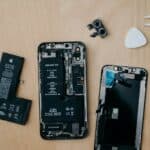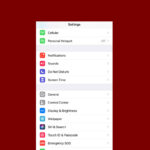Smartphones have become essential tools in our daily lives – and we all know the latest and greatest (iPhone 16, Samsung S24, Pixel 9, etc.) can cost quite a bit. So we’re taking a look at the best “budget” phones for 2025. Most of these phones can be picked up used or second hand in great condition and while they may not be the top tech out there, they’re definitely a huge upgrade for people with phones that are several years old.
The best budget phones offer a balance of performance, features, and value. Top models for 2025 include advanced cameras, powerful processors, and long battery life. Some phones excel at specific tasks like photography or gaming, while others aim to be great all-rounders. This guide will help you find the perfect phone for your needs and budget.
1) Apple iPhone 15 Pro
The iPhone 15 Pro stands out as a top contender in the budget/used smartphone market. It boasts the powerful A17 Pro chip, which outperforms its predecessor in benchmark tests. This new processor ensures smooth performance for demanding tasks and apps.
Apple has upgraded the camera system on the 15 Pro. It offers various focal lengths including ultra-wide, 24mm, 28mm, and 35mm options. The device also features a 5x optical zoom capability for improved long-range photography.
The phone comes in four storage variants: 128GB, 256GB, 512GB, and 1TB. This range of options caters to different user needs and budgets.
Apple has maintained its commitment to premium build quality with the 15 Pro. The device sports a durable design and high-quality materials. It continues to offer features like Face ID for secure authentication and 5G connectivity for fast data speeds.
The iPhone 15 Pro runs on iOS, known for its user-friendly interface and robust ecosystem of apps. Regular software updates from Apple ensure the device stays current with new features and security patches.
2) Samsung Galaxy S23 Ultra
The Samsung Galaxy S23 Ultra also can deliver top-tier smartphone and can easily be purchased in great “used” condition almost anywhere. It boasts an impressive camera system that outshines many competitors. The device features a powerful 200MP main camera sensor.
This phone excels in productivity thanks to its built-in S Pen stylus. Users can take notes, draw, and navigate the device with precision. The S Pen sets it apart from other flagship phones.
The S23 Ultra’s display is a standout feature. It offers a bright, colorful screen that reaches up to 1750 nits of peak brightness. This makes it easy to use outdoors in sunny conditions.
Performance is another strong point for the S23 Ultra. It runs on the Snapdragon 8 Gen 2 chip, ensuring smooth operation for demanding tasks and games. The phone also comes with ample storage options.
Battery life is solid on the S23 Ultra. It can easily last through a full day of heavy use. The device also supports fast charging and wireless charging for added convenience.
While the S23 Ultra offers top-notch features, it comes at a premium price. It starts at $1199 for the base model. This puts it in the upper tier of smartphone pricing.
3) Google Pixel 8
The Google Pixel 8 is a standout smartphone in today’s market, even though it has been replaced by the Pixel 9. It boasts a compact design that fits comfortably in hand. The phone measures 5.9 x 2.8 x 0.4 inches and weighs 6.6 ounces.
Its 6.2-inch OLED screen offers crisp visuals with a resolution of 2,400 by 1,080 pixels. Google calls this an Actua display. It aims to show colors more accurately.
The Pixel 8 shines in photography. It features AI-enhanced photo capabilities that set it apart from competitors. The Best Take feature allows users to create the perfect group photo.
Google has priced the Pixel 8 at $699. This is a $100 increase from previous models. Despite the higher cost it remains competitive in the mid-range smartphone market.
The phone runs on Google’s custom Tensor chip. This powers its advanced AI features. It also ensures smooth performance for everyday tasks and demanding apps.
Google promises seven years of software updates for the Pixel 8. This commitment to long-term support adds significant value for users who keep their phones for several years.
4) OnePlus 11
The OnePlus 11 was replaced by the OnePlus 12 in early 2024, but the 11 still stands out as a top-tier Android smartphone. It boasts exceptional performance and great battery life. Users can expect smooth operation and long-lasting power throughout the day.
This phone features a stunning display. The 6.7-inch AMOLED screen delivers vibrant colors and sharp images. It’s perfect for watching videos or browsing photos.
Camera quality on the OnePlus 11 impresses many users. The 50MP main sensor captures excellent photos. It takes some of the best pictures seen on a OnePlus device to date.
Battery life is a strong point for the OnePlus 11. In tests it lasted over 13 hours of continuous web browsing. This means most users won’t need to charge during a typical day.
The OnePlus 11 offers great value for its price. It provides flagship-level features without the premium cost of some competitors. This makes it an attractive option for those seeking high-end performance on a budget.
5) Sony Xperia 1 V
The Sony Xperia 1 V stands out as a top-tier smartphone for camera enthusiasts. It boasts a trio of powerful rear lenses, including a 24mm wide-angle, 16mm ultrawide, and 85-125mm periscope telephoto.
These cameras pack a punch with 20fps burst shooting and 4K video recording at 120fps. The phone caters to both casual users and pros who want manual control over their shots.
The Xperia 1 V features a stunning 4K HDR OLED display with a 21:9 aspect ratio. This tall, slim screen is perfect for watching movies and TV shows in their original format.
Sony has kept its unique design approach with the Xperia 1 V. The phone maintains a sleek, professional look that sets it apart from other flagship devices. Its build quality matches its premium status.
While not as widely known as some rivals, the Xperia 1 V offers a mix of high-end specs and niche features. It’s a solid choice for those who value camera quality and a cinematic viewing experience in their smartphone.
6) Xiaomi 13 Pro
The Xiaomi 13 Pro stands out as a top contender in the smartphone market. It boasts a powerful camera system that rivals the best in the industry. The device features a large 1-inch sensor for stunning photo quality.
This phone packs a punch with its performance. It runs on the latest Snapdragon processor. The 13 Pro handles demanding tasks with ease. Users can expect smooth multitasking and lag-free gaming.
The display is another highlight. It sports a 6.67-inch OLED screen with vibrant colors and sharp details. The high refresh rate ensures fluid scrolling and animations.
Battery life doesn’t disappoint either. The 13 Pro comes with a large 5000mAh battery. It also supports 120W fast charging for quick top-ups.
Build quality is premium. The phone feels solid in hand with its glass and metal construction. It offers a sleek design that looks and feels high-end.
The Xiaomi 13 Pro competes well against flagships from other brands. It offers a great mix of features at a competitive price point. For those seeking a top-tier smartphone the 13 Pro is worth considering.
7) Oppo Find X6 Pro
The Oppo Find X6 Pro boasts an impressive display. Its 6.82-inch AMOLED screen offers a 2K resolution and peak brightness of 2,500 nits. This makes it one of the brightest phone screens available.
Camera performance is a key strength of this device. The Find X6 Pro features a large periscope zoom camera sensor. This allows for high-quality zoom shots that rival top competitors.
The phone’s design stands out from its peers. It sports a unique aesthetic that sets it apart from other flagships. The build quality is solid and feels premium in hand.
Under the hood the Find X6 Pro packs powerful hardware. It offers meaningful upgrades from its predecessor in terms of performance. The device handles demanding tasks with ease.
One drawback is limited availability. The Find X6 Pro may not be sold in all markets. This could make it hard for some users to purchase.
Despite this the Oppo Find X6 Pro remains a top contender in the smartphone space. It combines a stunning display excellent cameras and strong performance in an eye-catching package.
8) Huawei P60 Pro
The Huawei P60 Pro stands out as a top-tier camera phone. It boasts a variable aperture main lens that adapts to different lighting conditions.
The phone’s multi-purpose telephoto lens shines in low light situations. It also excels at macro photography, capturing stunning close-up shots.
Huawei optimized the EMUI 13.1 interface for smooth performance. Users will appreciate the satisfying gesture controls on this device.
The P60 Pro’s design turns heads with its elegant aesthetic. Its build quality matches what you’d expect from a premium smartphone.
Despite its strengths, the P60 Pro has some drawbacks. It lacks Google apps and 5G support due to ongoing restrictions.
For photography enthusiasts, the P60 Pro offers powerful shooting capabilities. Its camera system rivals and often surpasses other flagship phones.
The phone delivers impressive results in various lighting conditions. From bright daylight to dim indoor settings, it captures quality images consistently.
9) Asus ROG Phone 7
The Asus ROG Phone 7 is a top-tier gaming smartphone. It boasts the powerful Snapdragon 8 Gen 2 chip, which is 15% faster than its predecessor. This processor ensures smooth gameplay and quick app launches.
The device features a bright 6.8-inch AMOLED display. Its 2448×1080 resolution and high refresh rate make games and videos look crisp and fluid. The screen’s responsiveness enhances the gaming experience.
Asus equipped the ROG Phone 7 with 16GB of RAM. This ample memory allows for seamless multitasking and quick app switching. Gamers can run demanding titles without lag or stuttering.
The phone’s camera system includes a 50-megapixel main camera. It also has ultrawide and macro lenses for versatile photography. The 32-megapixel front camera takes clear selfies.
Battery life is crucial for gaming phones. The ROG Phone 7 doesn’t disappoint with its large battery capacity. It supports fast charging to minimize downtime between gaming sessions.
10) Motorola Edge 40
The Motorola Edge 40 offers a sleek design and solid performance. It boasts a slim profile at just 7.58mm thick and weighs only 172g. This makes it lighter than many rivals with similar screen sizes.
The phone features a 6.7-inch display with a 165Hz refresh rate. This high refresh rate ensures smooth scrolling and responsive touch input. The Edge 40 runs on a clean version of Android without bloatware.
Battery life is a strong point for the Edge 40. It provides long-lasting performance throughout the day. The device also supports fast charging capabilities.
Camera performance is decent but not class-leading. The Edge 40 includes multiple rear cameras. However, it may not match the photo quality of some higher-end models.
The Motorola Edge 40 comes with a full setup in the box. This includes the phone, a USB-C cable, and a fast charging brick. A thin transparent case is also provided for basic protection.
Key Features to Consider
When choosing a phone, focus on display quality, battery life, and camera performance. These factors greatly impact your daily use and satisfaction with the device.
Display Quality
A high-quality display enhances your viewing experience. Look for phones with OLED or AMOLED screens. These offer vibrant colors and deep blacks.
Screen resolution is crucial. Full HD (1920×1080) is good for most users. Quad HD (2560×1440) provides sharper images. Some flagship models even offer 4K resolution.
Refresh rate matters too. A 90Hz or 120Hz display gives smoother scrolling and animations. It’s especially noticeable in gaming and fast-moving content.
HDR support improves contrast and color range. This makes videos and photos look more lifelike. Many top phones now include HDR10+ or Dolby Vision.
Battery Life
Long battery life is essential for modern smartphones. Look for phones with at least 4000mAh capacity. Larger batteries usually mean longer runtime.
Fast charging is now standard on many phones. It can refill your battery quickly when you’re in a hurry. Some phones offer 25W, 45W, or even higher charging speeds.
Wireless charging adds convenience. You can simply place your phone on a charging pad. No need to plug in cables. Some phones even support reverse wireless charging to power other devices.
Battery optimization features help extend runtime. Look for phones with adaptive battery tech. This learns your usage patterns and adjusts power consumption accordingly.
Camera Performance
Camera quality can make or break a phone purchase. Most high-end phones now offer multiple rear cameras. A typical setup includes main, ultra-wide, and telephoto lenses.
Megapixel count isn’t everything. Larger sensors and better image processing often matter more. They improve low-light performance and overall image quality.
Look for phones with optical image stabilization (OIS). It reduces blur from hand shake. This is especially useful in low light or when zooming.
Video capabilities are increasingly important. 4K recording at 60fps is common on flagship phones. Some even offer 8K recording. Look for features like HDR video and cinematic modes for more creative options.
AI-enhanced photography is a growing trend. It can improve image quality, offer better scene detection, and enable features like portrait mode on single-lens cameras.
Understanding Operating Systems
Mobile operating systems power our smartphones. They manage hardware, run apps, and provide user interfaces. Android and iOS dominate the market today.
Overview of Android
Android is an open-source OS developed by Google. It runs on a wide range of devices from many manufacturers. This variety gives users more choices in terms of features and price points.
Android offers high customization. Users can change launchers, keyboards, and default apps. The Google Play Store hosts millions of apps. Many are free or have free versions.
Android updates roll out slower than iOS due to fragmentation. Different phone makers and models get updates at varying times. Only about 12% of devices run the latest Android 13.
Key Android features include:
• Google Assistant integration
• Split-screen multitasking
• Customizable widgets
• USB-C connectivity on most devices
iOS Essentials
iOS is Apple’s mobile operating system. It powers iPhones and iPads. Apple designs both the hardware and software, leading to tight integration.
iOS offers a simpler, more uniform experience across devices. The App Store has strict quality control. This results in fewer but often higher-quality apps.
Apple provides software updates for 5-6 years. Most users can install new iOS versions on release day. This ensures better security and access to new features.
iOS standout features include:
• iMessage for seamless texting between Apple devices
• FaceTime for video calls
• Airdrop for easy file sharing
• Apple Pay for secure payments
iOS integrates well with other Apple products like Macs and Apple Watches. This ecosystem can be a major draw for some users.
Frequently Asked Questions
Smartphone technology advances rapidly. The market offers diverse options for various needs and budgets. Let’s explore the current landscape of mobile devices.
What are the top 10 Budget smartphones in the market right now?
The best budget phones in 2025 include the Apple iPhone 15 Pro and Samsung Galaxy S23 Ultra. These devices lead in performance and features. The Google Pixel 8 and OnePlus 11 also rank highly. They offer excellent value and unique capabilities.
Sony’s Xperia 1 V rounds out the top five with its pro-grade camera system. Other notable models come from brands like Xiaomi Motorola and Asus. Each brings something special to the table.
Which Older-Model smartphones offer the best camera performance?
Camera quality remains a key factor for many buyers. The iPhone 15 Pro boasts a versatile triple-lens setup. It excels in various lighting conditions. Samsung’s Galaxy S23 Ultra pushes boundaries with its 200MP main sensor.
Google’s Pixel 8 leverages AI for impressive computational photography. The Sony Xperia 1 V caters to enthusiasts with manual controls. Many mid-range phones now offer camera features once reserved for flagships.
What is the most recommended smartphone for budget-conscious consumers?
Budget-friendly options have improved significantly. Android phones like the Google Pixel 7a offer great value. They provide solid performance and regular software updates.
Samsung’s A-series devices balance features and affordability. Brands like Motorola and OnePlus offer competitive options in the mid-range market. These phones often include features like 5G connectivity and multi-lens cameras.
Which smartphone is considered to have the best overall performance currently?
The Apple iPhone 15 Pro and Samsung Galaxy S23 Ultra lead in overall performance. They feature the latest processors and ample RAM. This ensures smooth multitasking and demanding apps run well.
The OnePlus 11 is known for its speed and efficiency. Google’s Pixel 8 optimizes performance through software. High refresh rate displays on these devices contribute to a fluid user experience.
What are the leading smartphone brands in terms of innovation and user experience?
Apple continues to set trends with its ecosystem integration. Samsung pushes boundaries in display technology and foldable designs. Google focuses on AI-driven features and clean software.
OnePlus garners praise for its fast charging and smooth interface. Sony caters to multimedia enthusiasts with its Xperia line. Each brand brings unique strengths to the smartphone market.
How do the latest smartphone models compare in terms of battery life and efficiency?
Battery life has improved across the board. Many flagship phones now last a full day or more on a single charge. The iPhone 15 Pro offers solid battery life with efficient power management.
Samsung’s Galaxy S23 Ultra boasts a large battery capacity. It supports long usage times. Google’s Pixel 8 optimizes battery life through adaptive features. Fast charging capabilities have become standard on most new smartphones.





